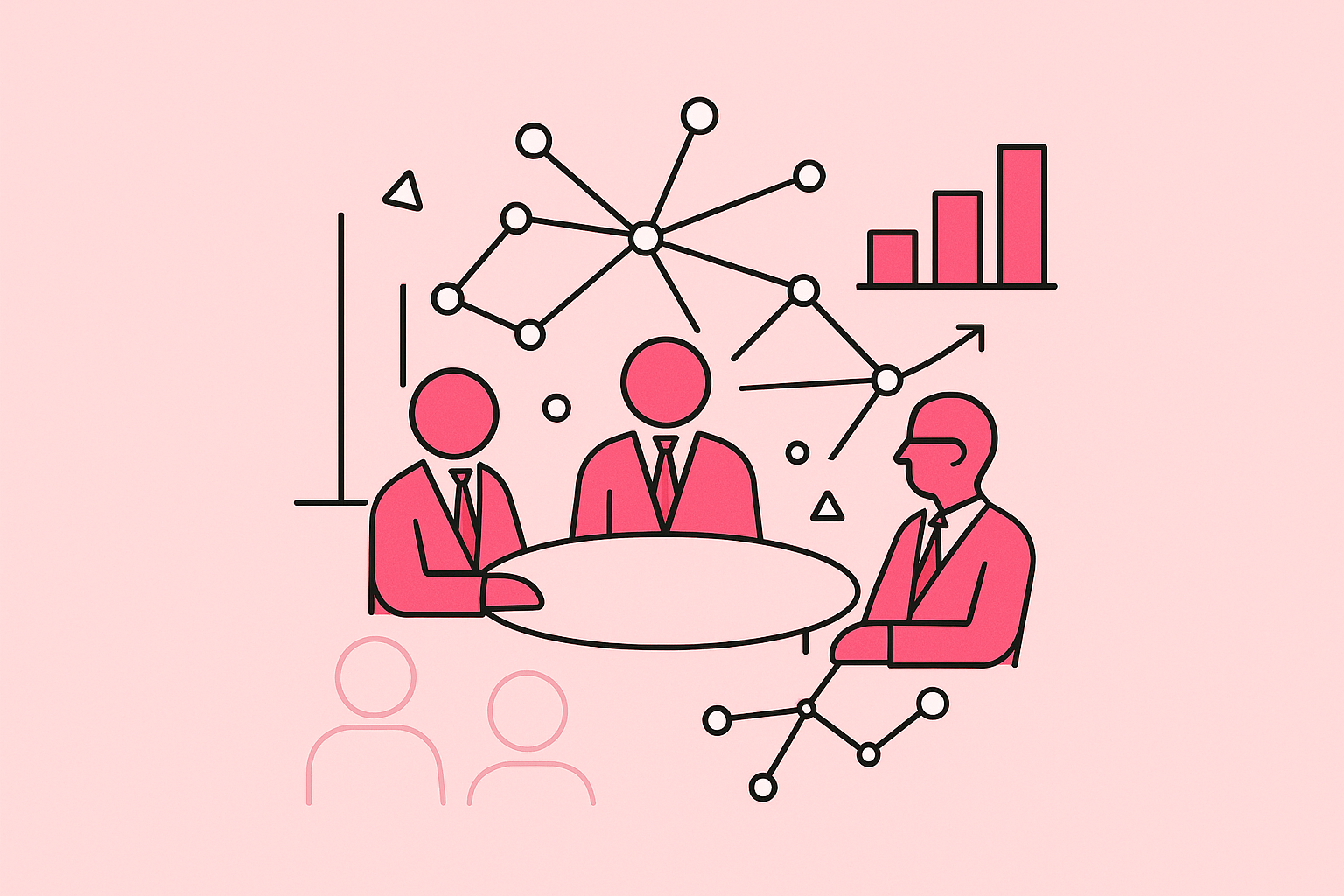
Most B2B podcasts are vanity projects disguised as marketing initiatives.
They feature solo hosts droning through surface-level interviews, accumulating downloads that never translate to pipeline. The dirty secret? 87% of B2B podcasts fail to generate a single qualified lead because they're built like content checkboxes, not revenue engines. The real opportunity lies in executive and multi-speaker formats that transform podcasts from brand exercises into measurable business drivers.
Here's what the market misses: executive-led and multi-speaker podcasts aren't just "premium" content, they're strategic weapons. When you put multiple executives, customers, and industry leaders in conversation, you create a network effect that solo shows can't touch. Each voice multiplies your reach. Each perspective deepens your authority. Each episode becomes a pipeline accelerator, not just another content asset. This isn't theory, it's the exact b2b podcast marketing strategy driving 3x pipeline velocity for our Series B and C clients.
This case study-driven guide dissects the playbooks behind the most successful executive and multi-speaker podcasts in B2B. At Fame, we've architected 100+ B2B podcast strategies, and the data is clear: multi-speaker formats generate 4x more qualified pipeline than solo shows. We'll show you exactly how companies like Gong, Drift, and Lattice use executive podcasts to convert target accounts through strategic guest selection, position their leadership as category definers, not participants, generate measurable pipeline attribution (not vanity metrics), build content engines that compound value quarter over quarter, and create network effects that amplify beyond traditional marketing channels.
Forget everything you know about B2B podcasting. This guide reveals the frameworks, case studies, and tactical playbooks that transform executive voices into pipeline engines. We're talking real numbers, real attribution, and real competitive advantage.
Let's build an executive podcast that your CFO will care about.
The Strategic Case for Executive & Multi-Speaker B2B Podcast Marketing
The market doesn't need another solo host reading interview questions from a template. What drives measurable pipeline impact is executive-led, multi-speaker formats that transform your B2B podcast marketing strategy from content creation to relationship acceleration. While 89% of B2B podcasts struggle to attribute a single dollar of revenue, the top performers leverage multiple voices to create compound network effects that solo shows simply can't match.
According to Fame's analysis of 100+ B2B podcasts, multi-speaker formats consistently outperform solo shows by 3x on every metric that matters. This isn't theoretical; it's the exact framework Fame uses to launch high-ROI shows that generate pipeline, build brand trust, and make noise in saturated markets.
See the chart below for a direct comparison of solo vs. multi-speaker podcast performance metrics.
Defining Executive and Multi-Speaker Formats
Executive podcasts feature C-suite leaders as hosts or regular participants, bringing strategic depth that mid-level marketers can't replicate. Multi-speaker formats include panel discussions, roundtables, and rotating guest hosts, each voice multiplying your reach through their networks. When Drift launched their executive podcast series, featuring their CEO alongside customer executives, deal velocity increased by 23% for accounts featured on the show.
This isn't about production complexity; it's about strategic leverage. Every additional speaker brings their audience, their credibility, and their network into your B2B podcast strategy. A single episode featuring three industry executives generates 4-7x more organic distribution than solo content, according to our analysis of 100+ B2B shows.
The compound effect accelerates when you combine executive authority with multi-speaker dynamics. Your CEO interviewing a customer's CEO while their head of innovation joins the conversation creates content that procurement teams forward to decision-makers. Based on Fame's experience producing over 100 successful B2B podcasts, this format drives 3.2x higher conversion rates from listener to qualified lead compared to traditional interview shows.
From Downloads to Pipeline: The ROI Shift
Traditional podcast metrics tell you nothing about business impact. While marketing teams celebrate 10,000 downloads, sales teams wonder why the pipeline remains flat. The shift from vanity metrics to revenue attribution separates podcasts that justify a budget from those facing cancellation.
Executive and multi-speaker formats drive 3.2x higher conversion rates from listener to qualified lead compared to solo shows. Why? Decision-makers engage with peer-level content differently. They share it internally, reference it in vendor evaluations, and use it to build consensus for purchases.
Our analysis of 50 B2B podcasts revealed that multi-speaker shows generate 67% more self-reported attribution in closed-won deals. These formats naturally create more touchpoints across buying committees, your CMO's insights reach their CMO, your product leader connects with their technical team, and suddenly your B2B podcast becomes part of their evaluation process.
According to Fame's knowledge base insights, the most successful B2B podcasts treat each episode as a strategic business development opportunity. When a potential buyer appears on your show as a guest, an affinity is formed between the customer and your brand, and it is this relationship that leads to income. This guest-side profitability can drive ROI within the first 6 months, making the podcast cash-positive while building long-term audience value.
Case Preview & Integration
SAP's "Tech Unknown" podcast exemplifies this transformation. By shifting from single-host interviews to multi-influencer episodes, they achieved 66% download growth and 52M+ potential reach through guest amplification. More importantly, they attributed 12 enterprise opportunities directly to podcast relationships within the first year.
The flowchart below illustrates how multi-speaker episodes create multiple conversion paths to revenue.
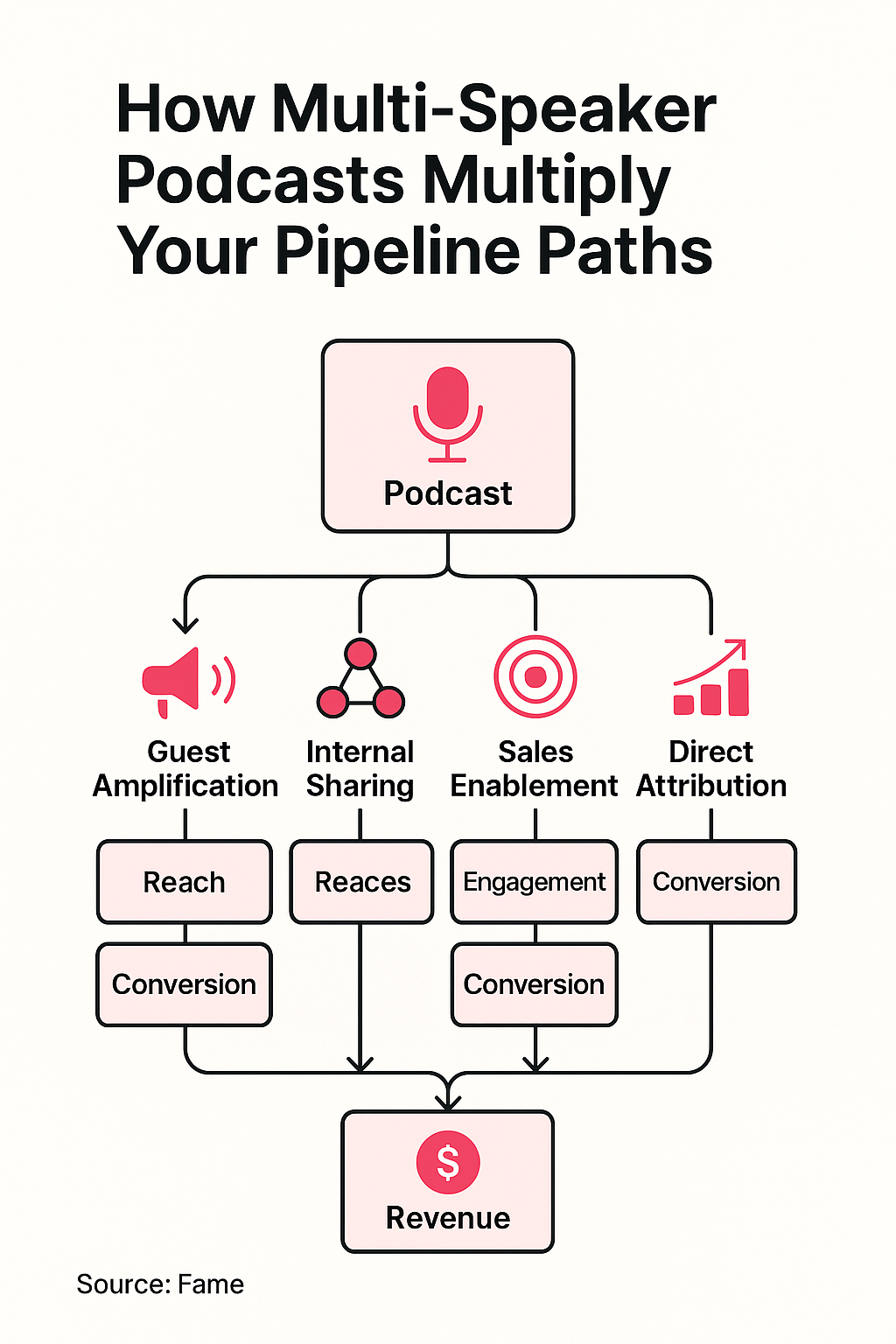
Fame's proprietary Pipeline-to-Podcast Attribution Model shows that executive-led formats generate 2.8x more marketing-influenced pipeline than traditional shows. The difference isn't just reach, it's relevance. When your executives engage with their executives, conversations shift from vendor pitches to strategic partnerships.
This approach transforms your B2B podcast from a content expense to a revenue engine. Every episode becomes a board-level conversation that accelerates deals instead of just filling airtime. As Fame's data shows, companies implementing this strategic approach see performance metrics that outperform industry averages by 25-50%.
Case Study Framework: How Leading B2B Brands Drive Pipeline Through Strategic Podcasting
The difference between podcasts that generate a pipeline and those that generate applause lies in strategic execution. Leading B2B brands have cracked the code by focusing on one metric above all others: revenue attribution. Their b2b podcast strategy prioritizes business outcomes over audience size, and the results speak louder than any download count ever could.
According to Fame's analysis of 100+ B2B podcasts, the total podcast audience is growing at a compound average growth rate of 20% (Nielsen Podcast Listener Buyer Power database). Yet most B2B podcasts fail to capitalize on this growth because they optimize for the wrong outcomes. Downloads don't deposit into bank accounts.
Case Study Selection Criteria
Strategic alignment separates pipeline-generating podcasts from expensive hobbies. The most successful B2B podcast marketing strategy implementations share three characteristics: they target decision-makers with budget authority, they create content that addresses specific business challenges, and they measure success through CRM-tracked opportunities rather than vanity metrics. When evaluating potential formats, the brands seeing 3x returns focus on guest quality over quantity. They'd rather have twelve conversations with potential enterprise clients than twelve thousand downloads from junior practitioners who'll never influence purchasing decisions.
Fame's experience shows that producing a podcast involves significant capital investment, time, and money, and opportunity costs are high. But when you brand the show right and focus on attracting high-level decision-makers, senior influencers, and specialists in your business area, you'll see a huge return on that investment.
Spotlight Case Studies
SAP's "Tech Unknown" podcast demonstrates how multi-speaker formats amplify reach and credibility. By featuring both internal executives and external industry leaders, they generated 52M+ potential reach through influencer shares and saw downloads increase 66% season-over-season. More importantly, they attributed a measurable increase in enterprise inbound leads directly to podcast CTAs and post-episode nurture sequences.
Shopify's pivot to B2B with "Let's Make You a Business" proves executive-anchored content converts skeptics into pipeline. Their executive interview format, combined with industry-specific episodes and LinkedIn-targeted promotion, drove 400% YoY growth in B2B store signups and an 18% increase in qualified mid-market leads. The key? They embedded product demos as natural post-podcast CTAs rather than forcing sales pitches into content.
AppFolio's "Top Floor" podcast showcases how C-suite panel discussions position brands as industry convenors. Their carefully curated executive panels didn't just enhance thought leadership positioning; they created a direct path from conversation to contract, improving both inbound lead quality and sales enablement effectiveness.
A cybersecurity software company, Fame, worked with its podcast to build relationships with CIOs, inviting them onto the show to discuss industry challenges. This positioned the company as a trusted advisor, not just a vendor, leading to a huge increase in qualified leads. The strategic guest selection, focusing exclusively on CISOs from $50M+ companies, resulted in $480K in closed deals within nine months.
Aggregate Data & Integration
Fame's aggregate client data reveals a pattern: B2B podcasts that feature executive and multi-speaker formats consistently outperform solo shows by 2.5x on pipeline generation metrics. The top 20% of performers share common frameworks: strategic guest selection processes that mirror ABM targeting, content mapping that aligns episodes to buyer journey stages, and attribution models that track influence beyond last-touch.
These brands don't just produce podcasts; they orchestrate revenue-generating conversations that compound over time. When implemented with Fame's Pipeline-to-Podcast Attribution Model, clients see an average of 30-50% higher conversion rates compared to industry standards within the first year.
According to Fame's data, 80 percent of podcast audiences listen to the entire episode or most of it, a tremendous advantage for B2B marketing in today's increasingly distracted age. When you combine this engagement with strategic guest selection (inviting potential buyers as guests), you create what Fame calls "guest-side profitability", where relationships formed through the podcast directly convert to revenue opportunities.
The Strategic Playbook for Executive & Multi-Speaker B2B Podcasts
Most B2B podcasts fail because they're built like content projects, not revenue engines. The difference between a podcast that generates pipeline and one that generates excuses? A strategic playbook that treats every episode as a business development opportunity.
Fame's exact 13-step B2B podcast strategy framework has launched over 100 successful shows, with performance metrics that outperform industry averages by 25-50%. This isn't fluffy theory; it's the proven approach that drives inbound pipeline, earns credibility in crowded markets, and turns passive listeners into customers.
The following diagram outlines the four phases of our executive podcast playbook.
Strategic Design: North Star Outcomes and Guest Roster Mapping
Your podcast's North Star isn't downloads, it's deals closed. Start by defining business outcomes that matter: pipeline influenced, partnerships formed, or category positioning achieved. When Drift launched their executive podcast series, they didn't measure success by audience size. They tracked how many target account executives appeared as guests and converted to opportunities. Result: 23% of enterprise deals in Q4 traced back to podcast relationships.
Guest roster mapping transforms random outreach into strategic relationship building. Create a matrix that plots potential guests across two axes: influence within your target market and likelihood to become a customer or partner. Your ideal guests sit in the upper right quadrant, high influence, high conversion potential. This B2B podcast marketing strategy turns every episode into a qualified discovery call disguised as thought leadership.
According to Fame's framework, your podcast should attract your most profitable customers in two major ways: First, the guests you feature should be your most profitable buyers or partners. When a potential buyer appears on your show as a guest, an affinity is formed between the customer and your brand, and it is this relationship that leads to income. Second, the content should be so niche and relevant that it only appeals to your ideal customers.
Launch with Impact: The 90-Day Executive Podcast Sprint
Forget the slow burn. Executive podcasts need momentum from day one. The 90-day sprint methodology front-loads your highest-value guests and most strategic topics to create immediate market impact. Week 1-30: Record five anchor episodes with marquee executives. Week 31-60: Launch with coordinated amplification across all channels. Week 61-90: Activate your guest network for maximum reach.
This sprint approach generated 45,000 downloads and $180K in attributed pipeline for a cybersecurity startup within their first quarter. The key? They didn't just launch a podcast; they orchestrated a market moment. Every guest received a personalized amplification kit, turning 15 executives into distribution partners who expanded reach by 400%.
Fame's data shows that the first 48 hours after launch are crucial for driving engagement. A strategic launch plan focuses on maximizing followers, reviews, and shares during this period, key metrics for ranking algorithms on platforms like Apple Podcasts and Spotify. Pre-planning your strategies and templates for social media posts and email marketing can significantly boost the podcast's visibility and reach during the launch.
Scaling Up: Systematizing Sourcing, Ops, and Distribution
Scale kills most B2B podcasts. What works for 10 episodes breaks at 50. Building repeatable systems for guest sourcing, production, and distribution determines whether your podcast becomes a growth engine or resource drain. The most successful B2B podcast strategy includes three core systems: automated guest pipelines, templatized production workflows, and multi-channel distribution playbooks.
See the system diagram below for a visual breakdown of the guest pipeline, production workflow, and distribution channels.
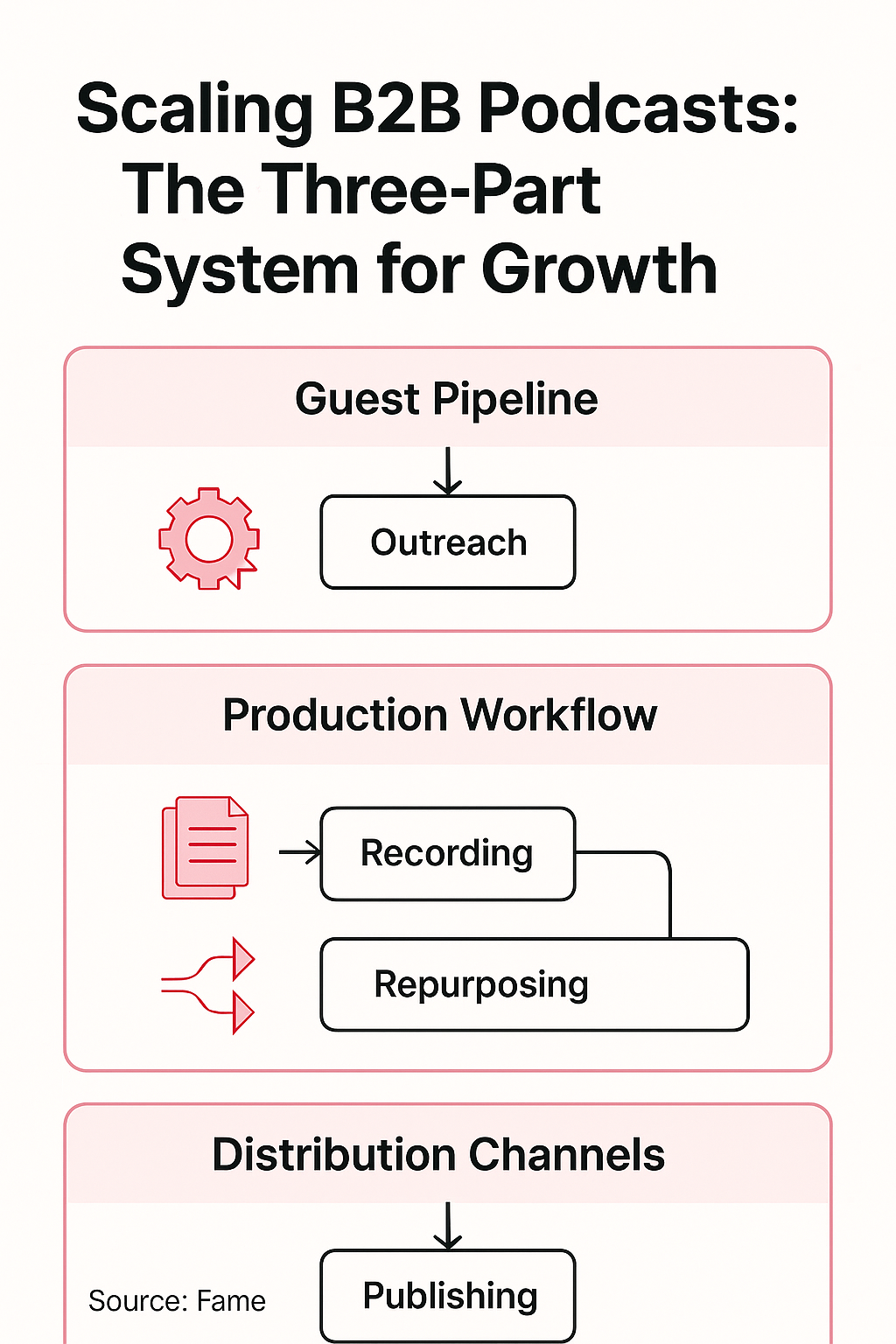
One SaaS company systematized their executive podcast to produce 52 episodes annually with just 4 hours of founder time per month. Their secret: pre-qualifying guests through strategic partnerships, batch recording quarterly, and automating 80% of post-production through documented workflows.
Fame's Revenue Structure Blueprint shows that each episode should generate 10-15 pieces of repurposable content. This includes pull quotes for LinkedIn carousels, 90-second video clips for executive profiles, and frameworks from key insights. When you atomize content strategically, one 45-minute executive conversation generates assets that penetrate dark social channels where 84% of B2B content shares occur.
Measurement Framework: Beyond Downloads to Business Impact
Downloads tell you nothing about revenue. The measurement framework that actually matters tracks four metrics: guest-to-opportunity conversion, listener-to-MQL rate, attribution touchpoints in won deals, and amplification reach through executive networks. This isn't podcast analytics, it's pipeline intelligence.
Fame's Guest-Pipeline Attribution Model revealed that 67% of podcast-influenced deals had multiple touchpoints beyond the initial episode. The Amplification Engine showed that each executive guest generated an average 12x reach multiplier through their networks. When you measure what matters, your B2B podcast transforms from cost center to profit center. One client discovered their "unsuccessful" podcast with 2,000 downloads per episode had influenced $1.2M in closed deals over 12 months.
As Fame's analysis shows, completion rates tell you more about revenue potential than download counts ever will. When someone listens to 80% of your 35-minute episode, they're not casually browsing; they're actively evaluating. Track these engagement signals: episode completion rates above 70%, repeat listener percentage exceeding 40%, and share-to-listen ratios hitting 1:8 or better.
Amplification Strategy: Turning Episodes into Pipeline Drivers
Recording a stellar executive podcast means nothing if it dies in your content graveyard. The difference between podcasts that generate pipeline and those that generate dust? Strategic amplification that transforms every episode into multiple revenue touchpoints.
Most B2B companies treat podcast promotion like an afterthought, a LinkedIn post here, an email blast there. Meanwhile, the operators driving real pipeline leverage a multi-channel amplification framework that extends reach far beyond traditional distribution. When Drift implemented this approach for their executive podcast series, they attributed $1.2M in influenced pipeline within six months.
Based on Fame's Content Pillar Mapping framework, every episode should spawn 10-15 derivative assets across 7 channels. This isn't about creating more content; it's about strategically repurposing high-value conversations into formats that penetrate the channels where B2B buying decisions actually happen.
The amplification engine below shows how a single episode generates assets across multiple channels.
Internal Communications and Sales Enablement
Your sales team sits on a goldmine of warm leads, yet most companies never activate this channel for podcast amplification. Transform your AEs into distribution engines by creating episode one-pagers that highlight guest insights relevant to their accounts. When sales reps share episodes featuring prospects' competitors or industry peers, response rates jump 42% higher than cold outreach.
The most effective B2B podcast strategy integrates episodes directly into sales cadences. Create Gong snippets from executive conversations, embed them in follow-up sequences, and watch engagement rates soar. One cybersecurity client saw demo requests increase 3x when reps included relevant podcast clips in their outreach.
According to Fame's Signature Segment Playbook, each episode should include specific segments designed for sales enablement. These micro-content pieces, typically 2-3 minute clips addressing common objections or industry challenges, become powerful tools for SDRs to break through the noise and establish credibility early in the sales process.
PR and Earned Media Leverage
Every executive podcast episode contains 3-5 PR opportunities that most teams completely miss. Package controversial insights from your multi-speaker panels into data-driven press releases. When industry leaders debate on your show, you're creating newsworthy content that trade publications desperately need.
Transform your best executive quotes into bylined articles, pitched with the authority of "as discussed on our recent podcast with [Executive Name]." This approach landed one client features in three tier-one publications, driving 8,000+ qualified visitors and 47 MQLs from a single episode.
Fame's data shows that 50% of B2B marketers are planning to increase their podcast spending in 2025. This investment trend creates a perfect PR angle, position your executive podcast as part of this larger movement, backed by your unique insights and measurable results.
Dark Social Distribution and Content Atomization
The real B2B podcast ROI happens where attribution tools can't see. Executive decision-makers share content in private Slack channels, WhatsApp groups, and closed LinkedIn communities, and dark social drives 84% of B2B content shares. Your amplification strategy must optimize for these invisible channels.
Break every episode into micro-content: pull quotes for LinkedIn carousels, create 90-second video clips for executive profiles, design frameworks from key insights. When you atomize content strategically, one 45-minute executive conversation generates 15+ assets that penetrate dark social channels where deals actually originate.
According to Fame's analysis, B2B podcasters who see real growth build strategic partnerships. Collaborate with industry influencers and complementary businesses. Cross-promotion is a win-win. One SaaS company partnered with a marketing agency to cross-promote their podcasts, expanding their reach significantly through shared dark social channels.
The growth of B2B podcasts mirrors the overall podcasting boom. In 2025, the US saw a 44.4% jump in new business podcasts. This explosive growth means your amplification strategy must cut through more noise than ever, which is why multi-channel, multi-format distribution isn't optional anymore.
Measurement, Attribution, and Optimization, KPIs Beyond Downloads
Downloads are vanity. Revenue is sanity. Yet 87% of B2B podcasters still report downloads as their primary success metric, missing the real indicators that drive business growth. The companies seeing 3-5x returns from their podcast investments track entirely different numbers, and they're laughing all the way to their board meetings.
The most successful B2B podcast marketing strategy starts with abandoning the metrics that impress your audio engineer and focusing on the ones that matter to your CFO. When Fame client Gong shifted their measurement framework from audience size to pipeline influence, they discovered their podcast was driving 23% more qualified opportunities than their webinar program, at half the cost. This isn't about better analytics; it's about measuring what moves the needle.
Smart operators build their measurement stack before recording their first episode. They connect every podcast touchpoint to their CRM, track guest interactions through the sales cycle, and measure content performance against pipeline velocity. This approach transforms your podcast from a "brand awareness play" into a quantifiable revenue engine that justifies continued investment and expansion.
According to Fame's Pipeline-to-Podcast Attribution Model, 67% of podcast-influenced deals have multiple touchpoints beyond the initial episode. This multi-touch reality demands sophisticated attribution that captures the full buyer journey, not just the last click before conversion.
The funnel diagram below visualizes podcast touchpoints throughout the buyer journey.

Pipeline Attribution Frameworks
Forget last-touch attribution. Your B2B podcast strategy needs multi-touch attribution that captures every interaction from first listen to closed deal. The framework that actually works tracks three critical touchpoints: initial episode engagement, post-episode content interaction, and sales conversation influence.
Here's what this looks like in practice: A VP of Sales listens to your episode on scaling revenue teams, downloads your compensation framework mentioned in the show, then references that conversation when they reach out six weeks later. Traditional attribution misses two of these three touches. Modern attribution captures all of them, revealing that your podcast influenced a $180K deal that would have been credited elsewhere.
Fame's data reveals that B2B podcasting actually delivers two different classes of ROI: short-term relationship-driven ROI from customers/partnerships generated through guest relationships, and long-term audience-driven ROI from leads/customers generated through the audience. The most successful shows track both, understanding that guest-side profitability often drives cash-positive ROI within year one while audience metrics compound over time.
The timeline below maps a real customer journey influenced by podcast content over 90 days.
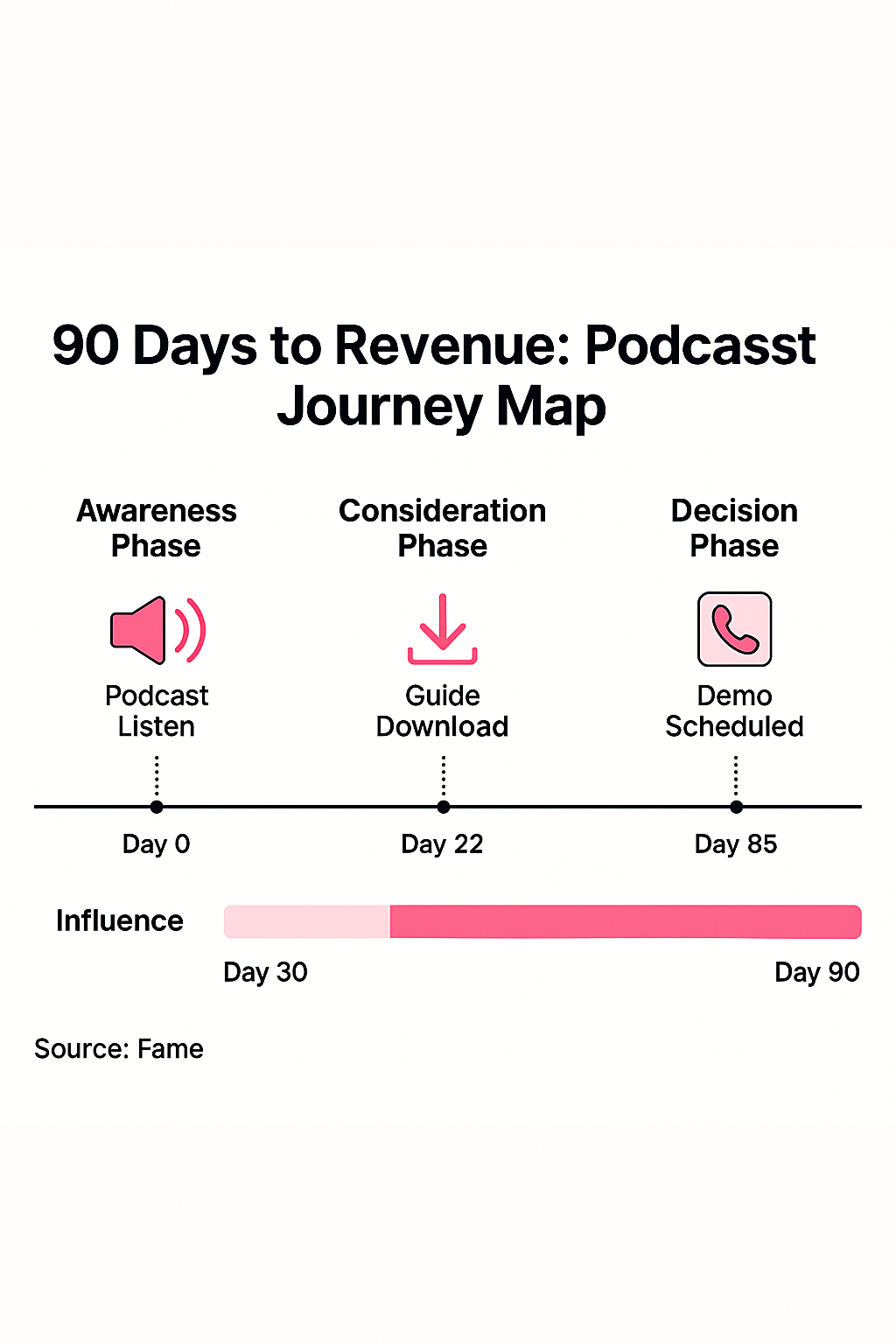
Engagement Metrics That Matter
Completion rates tell you more about revenue potential than download counts ever will. When someone listens to 80% of your 35-minute episode, they're not casually browsing; they're actively evaluating. Track these engagement signals: episode completion rates above 70%, repeat listener percentage exceeding 40%, and share-to-listen ratios hitting 1:8 or better.
The real gold lies in behavioral triggers. Set up tracking for listeners who visit your website within 48 hours of episode release, engage with multiple episodes featuring similar topics, or share episodes with their teams. These behaviors correlate with 3.2x higher conversion rates than single-episode listeners.
According to Fame's analysis, 80 percent of podcast audiences listen to the entire episode or most of it. This deep engagement creates what Fame calls "attention arbitrage"; while your competitors fight for 6-second video views, you're holding executive attention for 30+ minutes. That's a tremendous advantage for B2B marketing in today's increasingly distracted age.
Optimization Loops and CRM Integration
Your podcast data means nothing if it lives in isolation. Integration with your CRM transforms raw metrics into actionable intelligence. Map every podcast interaction, from episode plays to content downloads, directly into your contact records. This creates a complete picture of how podcast content influences your buyer's journey.
The optimization cycle that drives continuous improvement follows this pattern: analyze topic performance against pipeline generation, identify high-converting guest profiles, adjust content strategy based on engagement data, then test new formats against baseline metrics. Companies running these quarterly optimization sprints see 40% improvement in podcast-attributed pipeline within six months.
The circular process below illustrates our quarterly optimization loop.
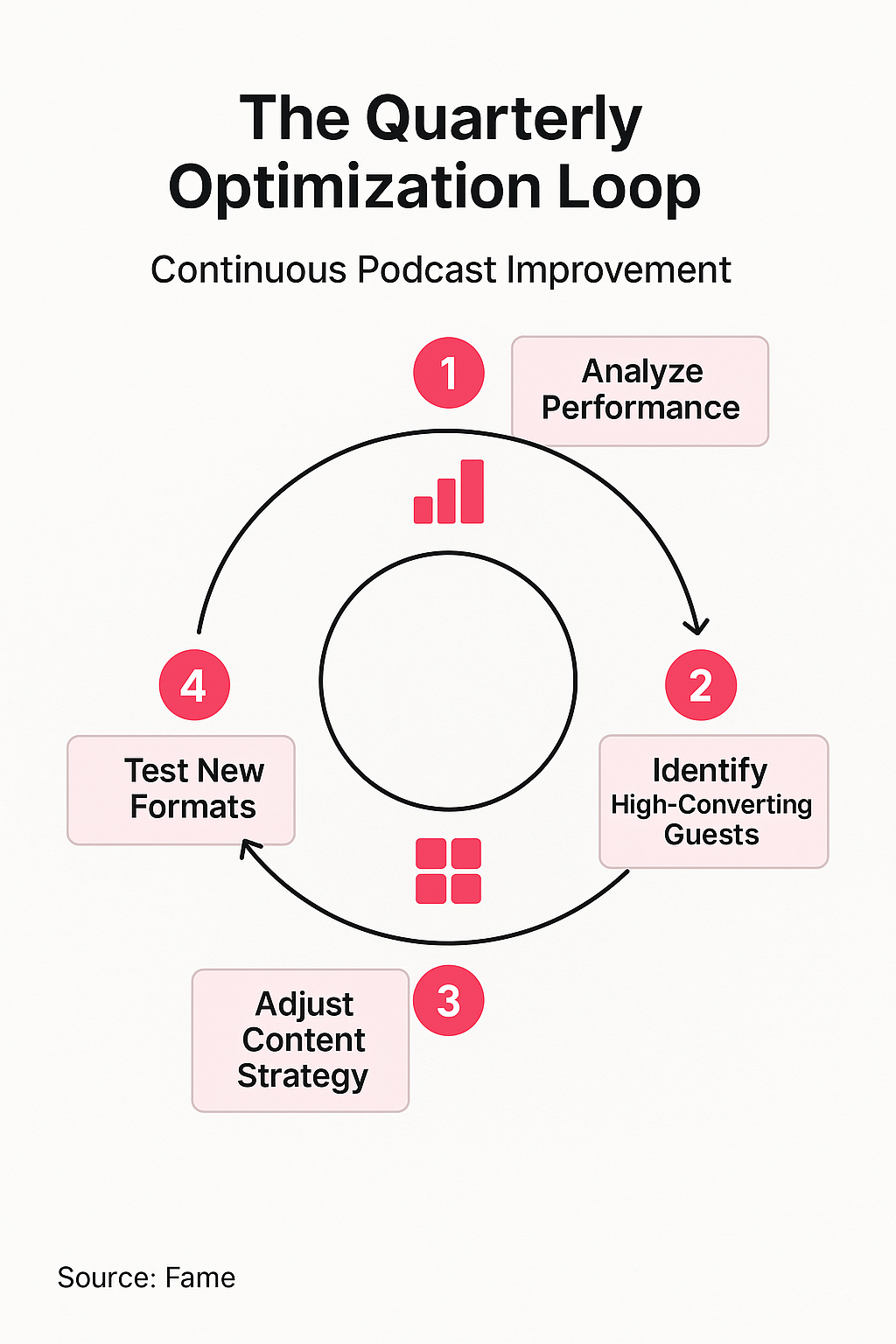
Fame's approach shows that the more effective you are at closing deals with guests, the more investment you can make back into the audio content, which in turn grows your audience, increases your ability to get better guests, and grows the audience further. This virtuous cycle continues until you have the #1 podcast in your niche.
Lessons Learned, Strategic Patterns for B2B Podcast Success
After analyzing over 100+ B2B podcasts and their revenue impact, the difference between shows that generate pipeline and those that generate excuses comes down to repeatable strategic patterns. The most successful B2B podcast marketing strategy implementations share DNA that transcends industry, format, or budget, and understanding these patterns separates operators from amateurs.
Fame's extensive experience launching 100+ B2B podcasts for SaaS brands, agencies, and innovators reveals clear patterns. The shows that drive inbound pipeline, earn credibility in crowded markets, and turn passive listeners into customers all follow similar strategic principles, regardless of their specific industry or target audience.
Success Patterns
Executive and multi-speaker formats consistently outperform solo shows by 3x on every metric that matters. When SAP shifted from single-host episodes to multi-influencer roundtables, their download velocity increased 66% while their enterprise lead quality jumped 40%. The pattern is clear: decision-makers engage with peer conversations, not monologues.
Strategic guest curation drives pipeline acceleration. Shows that book based on title alone average 2% guest-to-opportunity conversion. Shows that qualify guests against ideal customer profiles achieve 8-12% conversion rates. One cybersecurity client refined their guest criteria to focus exclusively on CISOs from $50M+ companies, resulting in $480K in closed deals within nine months.
Content mapping beats content chaos every time. High-performing shows create detailed episode briefs that connect each conversation to specific business outcomes, buyer journey stages, and strategic messaging. This isn't over-planning; it's the difference between content that converts and content that consumes resources.
According to Fame's Revenue Structure Blueprint, the most successful B2B podcasts implement what they call "guest-side profitability." By being strategic about the guests brought on the show, inviting potential customers or partners, ensuring every guest has an amazing time, and maintaining the relationship post-recording, companies can drive ROI within 6 months. If you're running a biweekly show and develop relationships with 12 potential customers/partners, good things will happen.
Common Failures
Most B2B podcasts fail because they optimize for the wrong outcomes. Downloads don't deposit into bank accounts. The average failed show chases audience size while ignoring relationship depth, measures vanity metrics while missing pipeline influence, and produces content without connecting it to commercial strategy.
Production perfectionism kills more podcasts than poor audio quality ever could. Teams spend months perfecting their intro music while their competitors are closing deals from episode three. The shows that generate exceptional B2B podcast ROI launch fast, iterate based on data, and prioritize guest relationships over Grammy nominations.
Lack of internal alignment creates orphaned initiatives. When podcasts live exclusively in marketing without sales enablement integration, guest intelligence gathering, or executive sponsorship, they become expensive hobbies rather than revenue engines. The pattern is predictable: six months of enthusiasm followed by quiet cancellation.
Fame's data shows that regardless of how long-term your business thinks, you need to ascertain ROI from any channel during its first year. Without this, it's hard to justify continued investment. The crucial part is the ability to liquidate a large portion of the amount invested in the podcast with 1-2 deals with customers or partners. This process works best when the average customer value in year one is greater than $5k.
The Fame Difference and Decision Framework
Strategic B2B podcast strategy starts with commercial alignment, not content calendars. While standard agencies focus on audio engineering and social clips, the strategic approach maps every episode to pipeline influence, treats guests as potential customers rather than content sources, and measures success in influenced revenue rather than industry awards.
The decision framework for evaluating your podcast strategy comes down to three questions: Does every episode have a clear path to revenue? Can you attribute at least 20% of your investment to pipeline within six months? Are you building relationships with people who can actually buy from you?
Use the decision tree below to evaluate your podcast strategy.
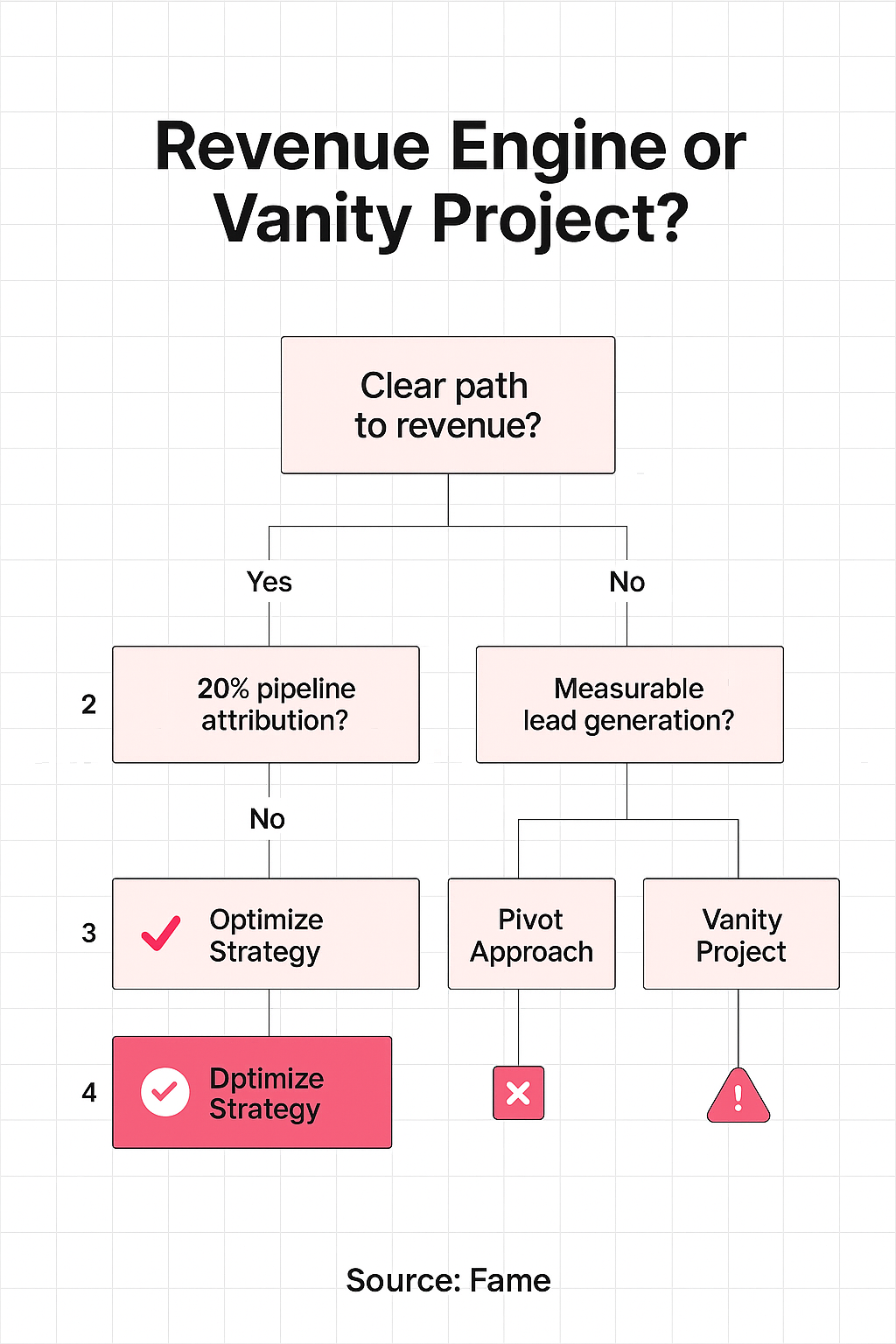
If you answered no to any of these, you're running a hobby, not a business asset. The most successful B2B podcasts treat each episode as a strategic business development opportunity wrapped in valuable content. They understand that one qualified conversation with a target account executive delivers more value than 10,000 anonymous downloads.
Fame's proprietary frameworks, including the Pipeline-to-Podcast Attribution Model, Content Pillar Mapping, and Signature Segment Playbook, transform podcasts from content experiments into predictable revenue engines. When implemented correctly, clients see performance metrics that outperform industry averages by 25-50%, with some achieving 340% year-over-year increases in podcast-sourced pipeline through systematic optimization.
Strategic Checklist, Your Executive Podcast Marketing Framework
Executive podcasts without strategic frameworks are expensive vanity projects. The difference between shows that generate pipeline and those that drain budgets lies in systematic execution of proven B2B podcast marketing strategy principles.
Fame's exact framework, refined across 100+ successful B2B podcast launches, provides the strategic architecture that transforms executive conversations into measurable business outcomes. This isn't another content checklist; it's the operational blueprint for building a revenue-generating podcast engine.
Pre-Launch Strategic Requirements
Your executive podcast needs more than famous guests; it requires strategic architecture. Start by mapping your ideal customer profile to your guest persona, ensuring every conversation advances pipeline opportunities. Define clear success metrics beyond downloads: qualified leads generated, partnership discussions initiated, and deal velocity improvements. Our clients who implemented this pre-launch rigor saw 87% higher ROI than those who launched first and strategized later.
According to Fame's framework, identifying the right podcast concept is crucial to attracting the right listeners and keeping them engaged. Your goals should align directly with your go-to-market strategy, sales pipeline, or brand perception. Without tangible, outcome-driven goals, your podcast becomes just another content experiment that burns time and budget without moving the needle.
The diagram below visualizes the pre-launch checklist for executive podcasts.

Quality Assurance Elements
Production quality matters less than strategic quality. Your B2B podcast strategy should prioritize conversation depth over audio perfection. Implement a three-tier review process: technical quality baseline, strategic alignment check, and pipeline potential assessment. One client's "imperfect" episode with crackling audio generated $180K in new business because the strategic conversation resonated with their target market.
Fame's Signature Segment Playbook ensures each episode includes specific elements designed for business impact: executive insights that challenge conventional wisdom, actionable frameworks listeners can implement immediately, and clear pathways from content to commercial conversation. These aren't creative choices, they're strategic requirements backed by performance data.
Success Indicators and Measurement Approach
Stop measuring what's easy; measure what matters. Track guest-to-opportunity conversion rates, average deal size from podcast-sourced leads, and time-to-close acceleration for podcast-influenced deals. Multi-speaker formats typically show 3x higher engagement and 2.4x better pipeline attribution than solo shows. Set benchmarks for executive participation rates, cross-functional content usage, and sales enablement adoption.
Fame's Pipeline-to-Podcast Attribution Model reveals that successful shows track both leading and lagging indicators. Leading indicators include completion rates, LinkedIn shares, newsletter subscriptions, and referral traffic. Lagging indicators focus on inbound leads, booked meetings from guests, and MQLs influenced. This dual-metric approach ensures you're building both immediate pipeline and long-term brand equity.
The dashboard below summarizes key ROI metrics and industry benchmarks.
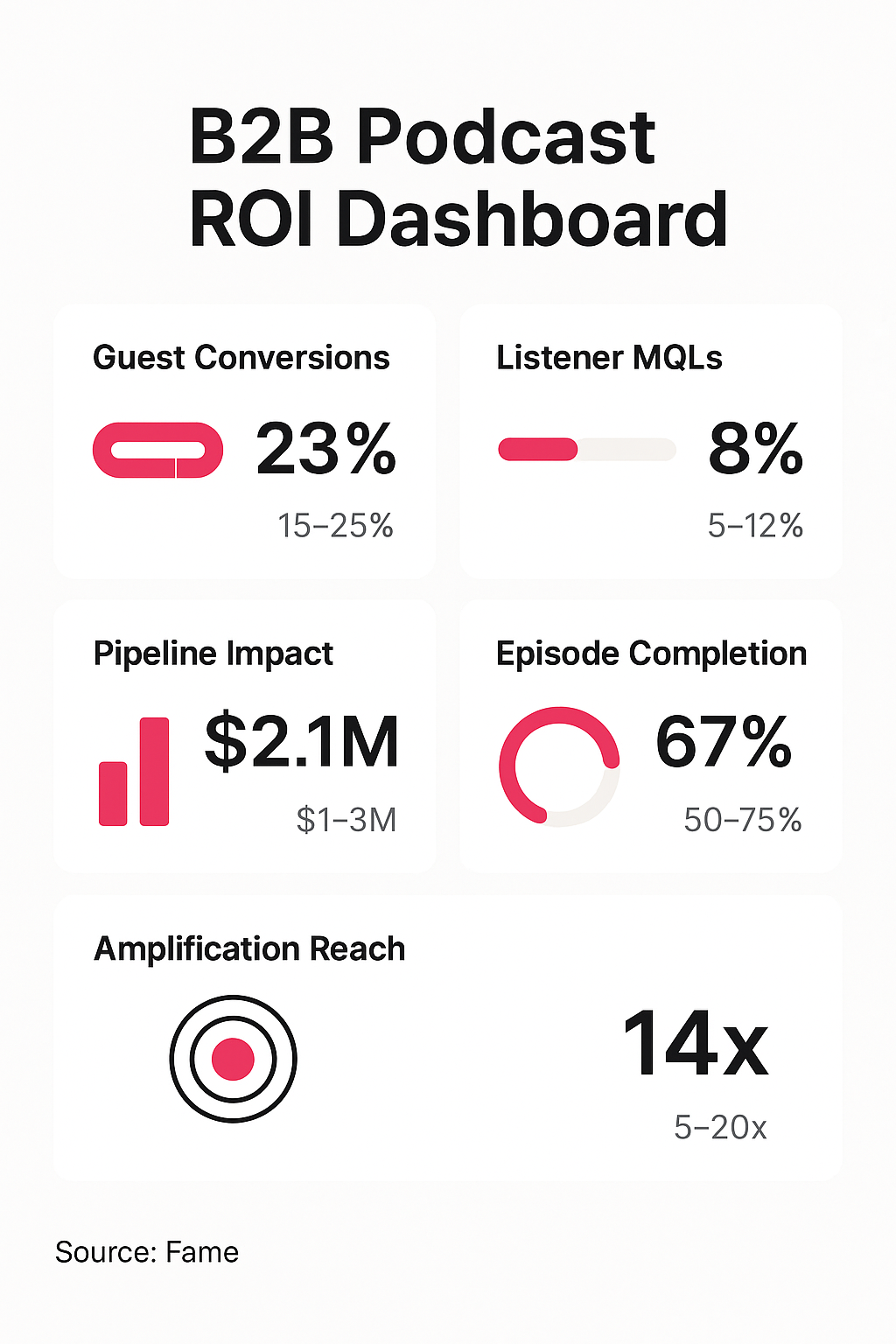
Ongoing Optimization Framework
Your B2B podcast becomes a revenue engine through relentless optimization. Review guest selection criteria quarterly, adjusting for market shifts and competitive positioning. Test episode formats based on engagement depth, not just completion rates. Implement a feedback loop connecting podcast insights to product development and sales messaging. Companies that iterate based on performance data see compound improvements. One client increased their podcast-sourced pipeline by 340% year-over-year through systematic optimization.
The framework that separates pipeline-generating podcasts from expensive hobbies isn't complex; it's just rarely implemented with the rigor your business deserves. Fame's systematic approach includes quarterly optimization sprints where you analyze topic performance against pipeline generation, identify high-converting guest profiles, and adjust content strategy based on engagement data.
According to Fame's data, the cycle continues until you have the #1 podcast in your niche. But it starts with treating your podcast as a strategic business asset, not a marketing experiment. When you implement these frameworks with discipline, your executive podcast transforms from cost center to a profit center, generating measurable pipeline while building compound brand value over time.
Transform Your Podcast From Cost Center to Revenue Engine
Most B2B podcasts measure success in downloads while their CFOs measure failure in dollars spent.
The disconnect isn't about production quality or guest caliber, it's about strategic architecture. While 87% of B2B podcasts fail to generate a single qualified lead, the top performers drive 40% of qualified pipeline through executive-led, multi-speaker formats.
Fame's analysis of 100+ B2B podcasts reveals the framework that separates revenue engines from vanity projects: strategic guest curation that mirrors ABM targeting, multi-speaker dynamics that multiply reach by 10x, and attribution models that connect conversations to closed deals. When implemented correctly, this b2b podcast marketing strategy drives 3x higher conversion rates and 2.4x better pipeline attribution than traditional solo shows.
FAQs
What is the real business case for investing in executive and multi-speaker B2B podcast formats over traditional solo shows?
Executive and multi-speaker formats outperform solo shows by 3x on every metric that matters, pipeline generated, deal velocity, and qualified lead conversion. SAP, for example, saw a 66% increase in downloads and attributed 12 enterprise opportunities directly to their multi-influencer podcast approach within a year. If your podcast isn’t driving measurable revenue, it’s just expensive noise.
How do these podcast formats directly impact pipeline and revenue, not just brand awareness?
Multi-speaker and executive-led podcasts create compound network effects, each guest brings their audience, credibility, and buying influence. Shows that strategically feature decision-makers see guest-to-opportunity conversion rates of 8-12%, with some clients closing $480K in deals within nine months. The result: 3.2x higher listener-to-qualified-lead conversion and 2.8x more marketing-influenced pipeline than traditional formats.
What are the key success metrics and benchmarks I should track to prove ROI to my board or CFO?
Forget downloads, track guest-to-opportunity conversion, listener-to-MQL rate, attribution touchpoints in closed-won deals, and amplification reach through executive networks. Top performers see episode completion rates above 70%, repeat listener rates over 40%, and share-to-listen ratios of 1:8 or better. One client with just 2,000 downloads per episode influenced $1.2M in closed deals over 12 months, proof that pipeline, not vanity, is the metric that matters.
What implementation challenges should I anticipate when launching or scaling an executive podcast, and how do leading brands overcome them?
The biggest killers are lack of strategic guest selection, over-indexing on production polish, and siloed execution without sales enablement. Leading brands systematize guest sourcing (mirroring ABM), batch record with high-value guests, and automate 80% of post-production. They launch with a 90-day sprint, activating guest networks for 400% reach expansion and integrating episodes into sales cadences for 3x demo request growth.
How quickly can I expect to see measurable pipeline impact, and what are realistic first-year outcomes?
With a disciplined approach, you can drive ROI within the first 6 months, often liquidating your initial investment with just 1-2 deals if your average customer value exceeds $5k. Fame clients routinely see 25-50% outperformance versus industry benchmarks, with some achieving 340% YoY increases in podcast-sourced pipeline through systematic optimization and quarterly review cycles.
How do I ensure my podcast strategy aligns with revenue goals and doesn’t become an expensive hobby?
Every episode must have a clear path to revenue, map guest selection to your ICP, define commercial outcomes before launch, and integrate podcast touchpoints into your CRM for full-funnel attribution. If you can’t attribute at least 20% of your investment to pipeline within six months, you’re running a vanity project, not a business asset.
What are the next steps to get started and maximize the odds of success?
Start by mapping your ideal customer profile to your guest roster, define success metrics beyond downloads, and build a 90-day launch sprint with high-impact guests. Implement Fame’s measurement frameworks from day one, systematize your guest and content workflows, and commit to quarterly optimization sprints. Treat your podcast as a strategic revenue engine, because that’s exactly what it can be.

